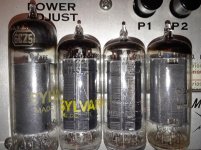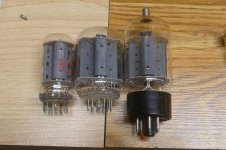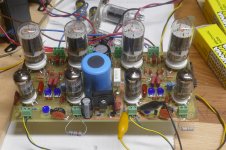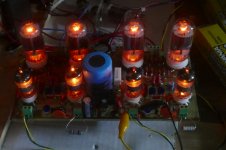Hello Gang,
I got some 6CZ5's that physically and electrically don't match.
I don't care too much about them being physically different but I assume they were made this way and it's normal?
What is really bugging me is the two in the middle. If you look closely the heater and cathode are WAY bigger. I mean at literally like quadruple the size. These variants are the ones that electrically don't match all my other 6CZ5's regardless of bottle size. The heater glows really bright and the tube gets very hot just sitting in my tube tester with just the heater powered. When I test them for transconductance with the 6CZ5 settings I get more than double what I should get. Regardless of large bottle of small bottle variants, the ones with little heater/cathodes get what I should get, ~5mA / V But the ones with the huge heater/cathodes I am getting 11mA / V 😱
What the heck is going on here? The gm more resembles a 6BQ5 but the box and tubes are both marked 6CZ5. Is there a tube with 6BQ5 gm but has a pinout like a 6CZ5?
So confused😕
Thanks,
-bird
I got some 6CZ5's that physically and electrically don't match.
I don't care too much about them being physically different but I assume they were made this way and it's normal?
What is really bugging me is the two in the middle. If you look closely the heater and cathode are WAY bigger. I mean at literally like quadruple the size. These variants are the ones that electrically don't match all my other 6CZ5's regardless of bottle size. The heater glows really bright and the tube gets very hot just sitting in my tube tester with just the heater powered. When I test them for transconductance with the 6CZ5 settings I get more than double what I should get. Regardless of large bottle of small bottle variants, the ones with little heater/cathodes get what I should get, ~5mA / V But the ones with the huge heater/cathodes I am getting 11mA / V 😱
What the heck is going on here? The gm more resembles a 6BQ5 but the box and tubes are both marked 6CZ5. Is there a tube with 6BQ5 gm but has a pinout like a 6CZ5?
So confused😕
Thanks,
-bird
Attachments
You have found another version of one of Sylvania's mystery tubes. Sylvania was the major player in this game, but I have also found some RCA made tubes and Philips/ECG branded Sylvania made tubes.
As the tube manufacturing era was winding down the major players had government / military contracts for spares to fulfill. Sometimes these contracts called for a supply of spares for certain pieces of equipment, and these were the only tubes being made on the entire production line. Assembly lines were being shut down and tube manufacturing plants closed. The manufacturers worked together to consolidate production onto a few assembly lines.
The manufacturers went to the contract holder and worked out a suitable replacement that could have been SPECIFIC to a SINGLE piece of equipment, that could be made on a production line with other tubes. These tubes were intended for use by the equipment manufacturer, and their specific customers, but after a couple dozen years or so they find their way to the surplus market.
This resulted in some creative glass stuffing, and as you have found some non - compatible tubes for general use.
The most common one of these was the stuffing of 7027A guts into 6BG6GA and 807 bottles. This is actually quite compatible and a major upgrade in the dissipation department. These are still for sale, but used to be cheap ($5 each).
6BG6 To 6L6 Vacuum Tube List
The oddest case I have seen was some 6B6GA's (a DHT) with 6AV5GA (A TV sweep pentode) guts inside connected as a triode. These were fairly common 20 years ago and led to my 6AV5 experiments. They are extinct now, but singles turn up on Ebay from time to time.
I have also seen some tubes that fried rather quickly, and some (possibly yours) that could cause equipment damage if used as random replacements. I found some RCA 6CW5's with tiny plates and lower heater consumption. They got extremely red hot plates if used in an audio amp where any common 6CW5 worked without issue. These were Canadian made RCA's with something much smaller stuffed inside.
I have 5 6CZ5's, all look like your two outer tubes. The inner two are unique, and possibly not intended for general use. The guts are obviously NOT 6CZ5's. What they are is not clear. The likely possibility is some other tube that has the same pinout as the 6CZ5, and may also exist with a different number and a different pinout. The obvious choices are the 6DT5 and 6EM5, although my few samples do not look like yours. Measuring the heater current may provide a clue as to which one.
It is also possible that those guts come from some other tube, probably one that still shipped with reasonable sales volume at the time those were made, like the 6BQ5.
The guts could also be unique to your particular tubes. Even in the tube heyday there were several "common" internal structures (cathode and grids) stuffed into different plates and glass, and (GE especially) a few plate structures used across whole families of tubes. If the contract was large enough it would be possible to stuff the glass with an odd combination, but this doesn't make sense, because it would be too far from the original design, spec's wise.
Well, you have two of them.....there may be more out there. Are they really 6BQ5's? Measure the heater current with a 6.3 volt DC supply. The 6CZ5 should draw 450 mA. The 6BQ5 should draw 760 mA which is rather unique. The 6DT5 will draw 1.2 amps and the 6EM5 draws 800 mA. Tube to tube differences may make it impossible to differentiate between 760 and 800 mA.
A long shot possibility is 6GM5 internals stuffed into a smaller plate and bottle, but the 6GM5 was never really popular despite it being an excellent tube.
As the tube manufacturing era was winding down the major players had government / military contracts for spares to fulfill. Sometimes these contracts called for a supply of spares for certain pieces of equipment, and these were the only tubes being made on the entire production line. Assembly lines were being shut down and tube manufacturing plants closed. The manufacturers worked together to consolidate production onto a few assembly lines.
The manufacturers went to the contract holder and worked out a suitable replacement that could have been SPECIFIC to a SINGLE piece of equipment, that could be made on a production line with other tubes. These tubes were intended for use by the equipment manufacturer, and their specific customers, but after a couple dozen years or so they find their way to the surplus market.
This resulted in some creative glass stuffing, and as you have found some non - compatible tubes for general use.
The most common one of these was the stuffing of 7027A guts into 6BG6GA and 807 bottles. This is actually quite compatible and a major upgrade in the dissipation department. These are still for sale, but used to be cheap ($5 each).
6BG6 To 6L6 Vacuum Tube List
The oddest case I have seen was some 6B6GA's (a DHT) with 6AV5GA (A TV sweep pentode) guts inside connected as a triode. These were fairly common 20 years ago and led to my 6AV5 experiments. They are extinct now, but singles turn up on Ebay from time to time.
I have also seen some tubes that fried rather quickly, and some (possibly yours) that could cause equipment damage if used as random replacements. I found some RCA 6CW5's with tiny plates and lower heater consumption. They got extremely red hot plates if used in an audio amp where any common 6CW5 worked without issue. These were Canadian made RCA's with something much smaller stuffed inside.
I have 5 6CZ5's, all look like your two outer tubes. The inner two are unique, and possibly not intended for general use. The guts are obviously NOT 6CZ5's. What they are is not clear. The likely possibility is some other tube that has the same pinout as the 6CZ5, and may also exist with a different number and a different pinout. The obvious choices are the 6DT5 and 6EM5, although my few samples do not look like yours. Measuring the heater current may provide a clue as to which one.
It is also possible that those guts come from some other tube, probably one that still shipped with reasonable sales volume at the time those were made, like the 6BQ5.
The guts could also be unique to your particular tubes. Even in the tube heyday there were several "common" internal structures (cathode and grids) stuffed into different plates and glass, and (GE especially) a few plate structures used across whole families of tubes. If the contract was large enough it would be possible to stuff the glass with an odd combination, but this doesn't make sense, because it would be too far from the original design, spec's wise.
Is there a tube with 6BQ5 gm but has a pinout like a 6CZ5?
Well, you have two of them.....there may be more out there. Are they really 6BQ5's? Measure the heater current with a 6.3 volt DC supply. The 6CZ5 should draw 450 mA. The 6BQ5 should draw 760 mA which is rather unique. The 6DT5 will draw 1.2 amps and the 6EM5 draws 800 mA. Tube to tube differences may make it impossible to differentiate between 760 and 800 mA.
A long shot possibility is 6GM5 internals stuffed into a smaller plate and bottle, but the 6GM5 was never really popular despite it being an excellent tube.
6DB5 is another one with ALMOST the same pinout of the 6CZ5 - and there's the 6DW5 (same pinout as 6CM6), both with 1.2A heaters. 6DB5 was common in TVs, 6DW5 is pretty rare.
Wow very informative thank you!
I measured the heater current and I am getting 1.2A.
When I increase bias to 1.5 on my tester (which is for a 6DB5) I still get 10mA / V which is very high for a 6DB5. Strange tube indeed.
I measured the heater current and I am getting 1.2A.
When I increase bias to 1.5 on my tester (which is for a 6DB5) I still get 10mA / V which is very high for a 6DB5. Strange tube indeed.
6DB5 is another one
Every 6DB5 I have seen has slots in the ends of the plate and small heat radiating fins on the side. It's basically a shrunken 6GC5, which is a rebottled 6W6GT. Gm on all of these is far lower than quoted here.......it's definitely a mystery tube of some sort.
Every 6DB5 I have seen has slots in the ends of the plate and small heat radiating fins on the side. It's basically a shrunken 6GC5, which is a rebottled 6W6GT. Gm on all of these is far lower than quoted here.......it's definitely a mystery tube of some sort.
I completely agree, I looked at datasheets for hours and can't find anything similar. The 6GC5 is probably closest but the gm is only 800 for those which on of my 'mystery tube' readings I am getting between 11000 and 13000 for gm.
I think I am going to just chock these up to mystery tube and throw them in a box forever, I have no use for them. George if you are interested in them I will mail them to you if you would like to blow them up. Where else to do you send a mystery species of tubes......a tubelab of course lololololololol
The 6DB5 is on my list to play with as a signal tube. That pup has nearly an 8W cathode heater...🙂 Hopefully that will translate in the same fashion as the 6CB5A with its 2.5A/6.3V heater does for power stage use. Those sweeps are something else.
cheers,
Douglas
cheers,
Douglas
The 6DB5 is 6W6 internals stuffed into a smaller plate and bottle. the 6W6GT, 6GC5, 6DB5, 12L6,25L6, and 50L6 all have the same internals, and share the same curves. If you choose to ignore a few specs, you can get 30 to 40 watts from a pair in AB2.
Is there a tube with 6BQ5 gm but has a pinout like a 6CZ5?
Yes!
7754
Nearly the same pin-out, just doesn't use pin 3. So what pin does the tube tester connect to for grid1, pin 3 or pin 6?
However, 7754 is a neonoval size tube, still 9 pin miniature base, but with a T9 1.183" diam. glass. The 7754 plate won't fit into a T6-1/2 glass like used for the 6CZ5.
So your two high gm "6CZ5" tubes may be composed of some standard stock but "wrong" parts for the cathode/grid assembly, but still using the 6CZ5 plate.
Possibly custom ordered, but you would think they would have used some different part #. Would be a real nightmare to get these mixed in with real 6CZ5 tubes.
Maybe a 6DB5 or 7754 cathode with 7754 grids and 6CZ5 plate. A 6BQ5 cathode looks too small compared to your pic. So you likely have a 7754 equivalent with only 10 Watt Pdiss. Could tell what is in there by measuring the g2/g1 Mu.
6CZ5 Mu 8 or 9
6DB5 Mu 6
7754 Mu 4
6BQ5 Mu 20
A curve trace could also identify the tube readily.
Curiously, there is a 9 Watt version of the 7754, the 6GF5. But that comes in a T9 bulb and Compactron base. Maybe these weird 6CZ5's were some experimental proto-types. Did your strange tubes come from Tektronix by any chance? 6GF5 was used by them in their O'scopes.
6GF5 was released by GE in Dec 1961. 6CZ5 was released by RCA in NOV 1956. 7754 was released by Sylvania in May 1960. 7695 released by Sylvania in March 1960. And 6GE5 was released by GE in Oct 1961. (6GF5 based on the 6GE5, and ultimately all of them, 7754/7695/6GF5/6GE5, are based on the 6DQ6B, GE Mar 1959)
Last edited:
When I was a kid in the 60's I became fascinated with the power and sound provided by some TV sweep tubes in my DIY guitar amps. Tubes from dead TV sets, radios and old HiFi's were plentiful and free from discarded trash. I had a small collection of the usual guitar amp stuff, but a much larger collection of all sorts of TV tubes.
It didn't take me very long to find that a 6W6 and a 6BQ6 could be made to work in Fender style schematics with a bit of parts tweaking. I didn't understand why the big fat TV sweep tubes like the 6DQ6 were not as loud and tended to glow red and provoke smoke from the OPT.
It wasn't until I learned things like impedance, bias, and load lines in high school electronics class that these things made sense and I could extract some power from the 6DQ6's, but by then even bigger TV tubes were available as people began to junk older color TV sets. I had often wondered just how much power could be extracted from the 6DQ6 and its relatives. I wouldn't revisit them until a few years ago.
The 7754 and 7695 are relatively uncommon. I have a pair of each somewhere and they do behave and look like 6DQ6's made by Sylvania. I have several of the odd voltage DQ6's, some 6GE5's and plenty of the 6GF5's. All have been thoroughly "tested" and I have designed a little test amp based on the 12 pin flavor. I haven't decided yet whether it will become a Tubelab PCB or not since I haven't had the time to chase a few gremlins out of the design.
Here is a picture of the test board. It makes 50 WPC when fed by the Antek toroid, and 80 WPC on a regulated 500 volt supply.
I'm not sure that the internals (everything but the plate) could be stuffed into a plate small enough to fit inside a standard 9 pin bottle. Sylvania has been known to stuff the glass with the complete guts of some different tube to fulfill a government contract, (the 6B4 with 6AV5 guts) but I can't see a tube company using mismatched guts to do this unless it was a very large contract, in which case these tubes should be more common.
OK, you got me curious. If you are willing to send them to me, I'll play with them then bust one open once it dies. I'll even pay the shipping. PM me if interested.
It didn't take me very long to find that a 6W6 and a 6BQ6 could be made to work in Fender style schematics with a bit of parts tweaking. I didn't understand why the big fat TV sweep tubes like the 6DQ6 were not as loud and tended to glow red and provoke smoke from the OPT.
It wasn't until I learned things like impedance, bias, and load lines in high school electronics class that these things made sense and I could extract some power from the 6DQ6's, but by then even bigger TV tubes were available as people began to junk older color TV sets. I had often wondered just how much power could be extracted from the 6DQ6 and its relatives. I wouldn't revisit them until a few years ago.
there is a 9 Watt version of the 7754, the 6GF5.....all of them, 7754/7695/6GF5/6GE5, are based on the 6DQ6B
The 7754 and 7695 are relatively uncommon. I have a pair of each somewhere and they do behave and look like 6DQ6's made by Sylvania. I have several of the odd voltage DQ6's, some 6GE5's and plenty of the 6GF5's. All have been thoroughly "tested" and I have designed a little test amp based on the 12 pin flavor. I haven't decided yet whether it will become a Tubelab PCB or not since I haven't had the time to chase a few gremlins out of the design.
Here is a picture of the test board. It makes 50 WPC when fed by the Antek toroid, and 80 WPC on a regulated 500 volt supply.
I'm not sure that the internals (everything but the plate) could be stuffed into a plate small enough to fit inside a standard 9 pin bottle. Sylvania has been known to stuff the glass with the complete guts of some different tube to fulfill a government contract, (the 6B4 with 6AV5 guts) but I can't see a tube company using mismatched guts to do this unless it was a very large contract, in which case these tubes should be more common.
I have no use for them. George if you are interested in them I will mail them to you if you would like to blow them up. Where else to do you send a mystery species of tubes......a tubelab of course lololololololol
OK, you got me curious. If you are willing to send them to me, I'll play with them then bust one open once it dies. I'll even pay the shipping. PM me if interested.
Attachments
After playing around with the calc's for gm, I've decided 6DB5 is more likely the "culprit" than the 7754. And it fits in the bottle too.
The 7754/7695 gets it's high 11000 gm by being rated way up at 100 mA. Derate that to the 46 mA the 6DB5 was rated at, and the calc'd gm drops to 6560 gm. While the 6DB5 at 46 mA is rated at 8000 gm.
So 6DB5 would be a higher gm tube than the 7754. But still not making the 11000 gm seen on the tester.
6BQ5 looks to have a somewhat smaller cathode width than seen in the mystery tube pic. So I think that's out.
Either an exceptionally friskie 6DB5,
-OR- maybe they used a newer cathode type with higher emission material than the tube was designed for. Seems like a plausible goof. The 6DB5 draws a whopping 1.2 Amp of heater current, only to get a wimpy 55 mA DC max current rating. Now look at a 6GE5 or 6GF5 at 1.2 Amps htr. and they have 175 or 160 mA DC max ratings. I'll bet someone used the wrong cathodes for those mystery tubes. Still would have to be a 6DB5 to have that size of cathode. Must have been a Monday, after a weekend of some hard drinking, to come up with those tubes! Or they couldn't hold up production while someone ordered some of the old type cathodes that they were out of.
Well, George would be the person to find out how much current they can -really- do.
A steady supply source for such a "rogue" tube could prove interesting.
The 7754/7695 gets it's high 11000 gm by being rated way up at 100 mA. Derate that to the 46 mA the 6DB5 was rated at, and the calc'd gm drops to 6560 gm. While the 6DB5 at 46 mA is rated at 8000 gm.
So 6DB5 would be a higher gm tube than the 7754. But still not making the 11000 gm seen on the tester.
6BQ5 looks to have a somewhat smaller cathode width than seen in the mystery tube pic. So I think that's out.
Either an exceptionally friskie 6DB5,
-OR- maybe they used a newer cathode type with higher emission material than the tube was designed for. Seems like a plausible goof. The 6DB5 draws a whopping 1.2 Amp of heater current, only to get a wimpy 55 mA DC max current rating. Now look at a 6GE5 or 6GF5 at 1.2 Amps htr. and they have 175 or 160 mA DC max ratings. I'll bet someone used the wrong cathodes for those mystery tubes. Still would have to be a 6DB5 to have that size of cathode. Must have been a Monday, after a weekend of some hard drinking, to come up with those tubes! Or they couldn't hold up production while someone ordered some of the old type cathodes that they were out of.
Well, George would be the person to find out how much current they can -really- do.
A steady supply source for such a "rogue" tube could prove interesting.
Last edited:
Looking at the "mystery" pics more closely, looks like one is a Sylvania and the other a Philco tube. But both have the same distinct 6CZ5 marking up top. More than likely these are some kind of counterfeit tubes (from 6DB5 or 6CS5). But now it becomes harder to account for the high gm. If there were a 5 or 4 Volt version of these, it could just be an over-voltaged heater, but I don't see such a version listed. And the current drawn agrees at 1.2 Amp. (although that is way too high for a 55 mA rated tube anyway, but it is spec.)
Last edited:
only to get a wimpy 55 mA DC max current rating.
Look again. 55 mA is the average cathode current. The peak cathode current rating is 200 mA as per the spec sheet. The 6DB5 is what you get when you stuff the internals of a 6W6GT into a tiny plate and cram all of that into a 9 pin bottle. The 6GC5 is the same tube with the full size 6W6GT plates. Both have similar pinouts and are interchangeably in my test amp with the exception that the bigger plates in the 6GC5 can be leaned on a bit harder, and thus can make a few more watts under continuous duty testing..........
Both tubes hit the 5% distortion point between 40 and 45 watts as does the 6W6GT. At 45 watts out (5.5 to 6% THD) all 3 tubes were burning about 15 watts in each plate and 1.4 watts in G2, all slightly over spec, but no glow noted. I pushed the drive higher which made more power and more distortion. The plate dissipation actually started going down due to the squaring of the output waveform. The screen grid in one 6DB5 showed a little color at 50 watts while the 6GC5 and 6W6 remained glow free at 55 watts out. The THD was in the 14 to 15 % range.
The above testing was done at 425 volts B+, 120 volts G2, 6600 ohm load, and 20 mA per tube idle current. No GNFB is used, mild plate to driver plate local feedback is employed. The driver board is this one:
Tubelab Universal Driver Board, 2015 version
This testing has convinced me that these tubes are indeed identical and the 50C5 isn't far from these either. The 32ET5 is a little different, but maybe within typical tube to tube variance. It wouldn't be too hard to stuff the mystery tube into the same socket as a 6DB5 or 6GC5 and see if it's is the same, or not.
I just came in from mowing the yard in 97 degree heat. After hugging the box fan and sucking down some Gatorade, I must return to the meltdown. I'll be back later....
Look again. 55 mA is the average cathode current. The peak cathode current rating is 200 mA as per the spec sheet.
Yes, agree. But the 6GF5 & 7764 give you 160 mA avg and 500 mA peak and the 6GE5/6JN5 give you 175 mA avg and 550 mA peak. All for the same 1.2 Amp of heater current. Bigger Sweep tubes do even better. For 2 Amps htr current, 6KG6 gives you 500 mA avg and 1400 mA peak.
Last edited:
I have a pretty good sized collection of 6DB5's. When I get some spare time I may try to find the real limits on peak cathode current......this is sometimes a destructive test and it usually takes out the cathode resistor when you find the limit via a tube arc, even if the tube survives.
I found that some very old 6L6GA's that I have will crank out 100 watts per pair into a 3300 ohm load and do it for a while without bother, but I have had 3 tube arcs when attempting to go beyond this power level. Each time the 1 ohm 1% 2 watt cathode resistor disintegrated but the tube survived and still made 100 watts just by changing the resistor.
So far tubes with bigger cathodes have not survived and two 6HJ5's have shattered. Both due to an impulse of current large enough to cause the glass to crack or shatter across the base pins on a line fropm the plate pin to the cathode pin. My biggest power supply (needed for amps over 100 watts) has 1000 uF of output capacitance and it was running at 500+ volts and the amp was making over 150 watts when the tube exploded.
Pics #1, #2, and #3 two pair of 6DQ6's cranking out 110 WPC. at 2.6% THD
Pic #4 a bunch of different kinds of 6L6's.
Pic #5 two pair of oldies cranking out 100 WPC.
Pic #6 two cathode resistors that died from attempting to hit 110 WPC
Pic #7 some NOS metal 6V6's making 35 WPC. I retested with old vintage glass tubes to verify that nothing was cooking inside. Then I put the metal tubes back in and hooked up some speakers for a couple days of listening.
I couldn't hear any difference between metal or glass, so the metal tubes will likely be saved for an all metal guitar amp. I have 8 X NOS metal 6V6's. They came in a box full of "unwanted" tubes given to me for free at the end of a hamfest.
I then cranked up some EL34's, 6550's, KT88's, 6W6's, 6BQ6's, and 6Y6GA's before swapping out the octal sockets for a fixture with both 7 and 9 pin sockets wired in parallel. Obviously you can only use one type at a time.
Pic #8, Left to right, 6GC5, 32ET5, 6DB5, 50C5.
Pic #9 6GC5's being tested. The pristine yellow Sylvania paint is no longer yellow!
Pic #10 A pair of NOS 50B5's making 50 watts in a dark room. The output is severely clipped in the scope picture, but I can't post it here.
I found that some very old 6L6GA's that I have will crank out 100 watts per pair into a 3300 ohm load and do it for a while without bother, but I have had 3 tube arcs when attempting to go beyond this power level. Each time the 1 ohm 1% 2 watt cathode resistor disintegrated but the tube survived and still made 100 watts just by changing the resistor.
So far tubes with bigger cathodes have not survived and two 6HJ5's have shattered. Both due to an impulse of current large enough to cause the glass to crack or shatter across the base pins on a line fropm the plate pin to the cathode pin. My biggest power supply (needed for amps over 100 watts) has 1000 uF of output capacitance and it was running at 500+ volts and the amp was making over 150 watts when the tube exploded.
Pics #1, #2, and #3 two pair of 6DQ6's cranking out 110 WPC. at 2.6% THD
Pic #4 a bunch of different kinds of 6L6's.
Pic #5 two pair of oldies cranking out 100 WPC.
Pic #6 two cathode resistors that died from attempting to hit 110 WPC
Pic #7 some NOS metal 6V6's making 35 WPC. I retested with old vintage glass tubes to verify that nothing was cooking inside. Then I put the metal tubes back in and hooked up some speakers for a couple days of listening.
I couldn't hear any difference between metal or glass, so the metal tubes will likely be saved for an all metal guitar amp. I have 8 X NOS metal 6V6's. They came in a box full of "unwanted" tubes given to me for free at the end of a hamfest.
I then cranked up some EL34's, 6550's, KT88's, 6W6's, 6BQ6's, and 6Y6GA's before swapping out the octal sockets for a fixture with both 7 and 9 pin sockets wired in parallel. Obviously you can only use one type at a time.
Pic #8, Left to right, 6GC5, 32ET5, 6DB5, 50C5.
Pic #9 6GC5's being tested. The pristine yellow Sylvania paint is no longer yellow!
Pic #10 A pair of NOS 50B5's making 50 watts in a dark room. The output is severely clipped in the scope picture, but I can't post it here.
Attachments
-
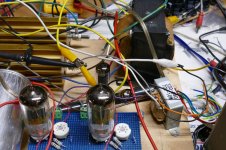 P1000809_x.jpg865.3 KB · Views: 133
P1000809_x.jpg865.3 KB · Views: 133 -
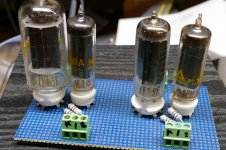 P1000744_x.jpg812.3 KB · Views: 113
P1000744_x.jpg812.3 KB · Views: 113 -
 P1000576_x.jpg884.8 KB · Views: 102
P1000576_x.jpg884.8 KB · Views: 102 -
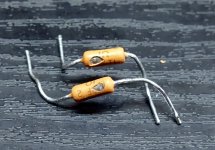 P1000567small_x.jpg678 KB · Views: 87
P1000567small_x.jpg678 KB · Views: 87 -
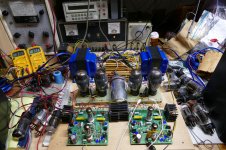 P1000512_x.jpg949.7 KB · Views: 119
P1000512_x.jpg949.7 KB · Views: 119 -
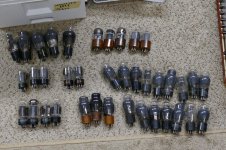 P1000522_x.jpg895.6 KB · Views: 149
P1000522_x.jpg895.6 KB · Views: 149 -
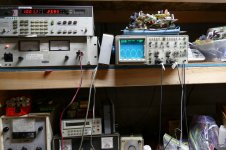 P1000508_x.jpg721.9 KB · Views: 88
P1000508_x.jpg721.9 KB · Views: 88 -
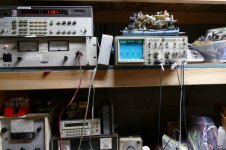 P1000507_x.jpg721.5 KB · Views: 133
P1000507_x.jpg721.5 KB · Views: 133 -
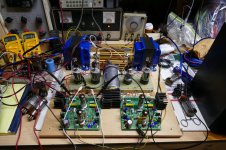 P1000509_x.jpg923 KB · Views: 154
P1000509_x.jpg923 KB · Views: 154 -
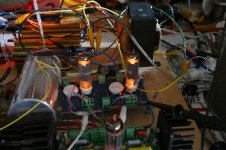 P1000819_x.jpg701.6 KB · Views: 103
P1000819_x.jpg701.6 KB · Views: 103
- Status
- Not open for further replies.
- Home
- Amplifiers
- Tubes / Valves
- 6CZ5 doppelganger
